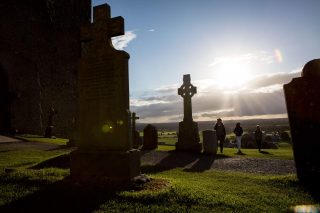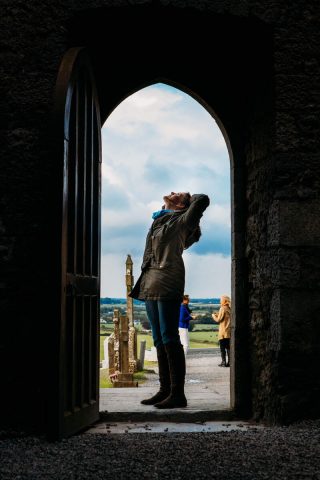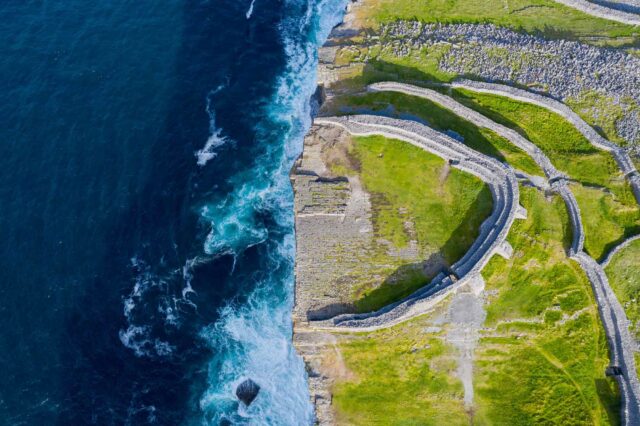One of the most commonly asked questions on a guided tour of the Rock of Cashel is “Are there ghosts here?” While I myself have never seen or felt anything out of the ordinary there are members of the public who claim to have done so. Let’s face it, with such a mixed and often tragic history, if ever a place was going to be haunted then the Rock of Cashel would surely be a prime location.
**************************************************************************************
The graveyard at the Rock of Cashel is one of the oldest active graveyards in Ireland. Historically the site dates back to the early fourth century when the Kings of Munster ruled high over the fertile planes of Tipperary, but the word Cashel derives from the gaelic word with the same pronunciation meaning a stone fortress. This suggests pre-Christian activity and, naturally, possible burials on the old limestone pedestal. Today, if you’re lucky enough to have had your name listed on the grave register from 1930, when your time finally comes you too could rest for eternity with Kings and Bishops.
Irish mythology has it that the Rock of Cashel was formed after the Devil took a huge bite out of the aptly named Devil’s Bit Mountain twenty miles north of Cashel. There is a large gap in the mountain between one outcrop ofrock and another small plateau. This was supposedly done to evade Saint Patrick who was banishing the pagan thoughts and customs that had ruled Ireland for millennia. In biting off this chunk of sandstone the Devil broke a tooth and as he flew south from the mountain he spat out the Rock of Cashel from his mouth to where it now stands. If this theory was to believed one of Ireland’s most iconic monuments was built on Satan’s tooth!

The Massacre of Cashel
In the summer of 1647 the Baron of Inchiquin, Murrough O’Brien, the Irish commander of the Protestant army of Cork under the control of Oliver Cromwell, commenced a campaign against the Irish Catholic strongholds in Munster. He met with little resistance and was allowed to make a major push towards the ecclesiastical centre of Cashel. The attack on the Rock of Cashel commenced on the 15th September 1647. Initially, the Irish defenders managed to protect the Cathedral, holding off the attackers trying to get through the doors, but the Parliamentarians then placed numerous ladders against the many windows in the Cathedral and swarmed the building. For another half an hour fighting raged inside the grounds, until the depleted defenders retreated up the bell tower. In the end all the soldiers and most of the civilians on the Rock were killed by the attackers. The Bishop and Mayor of Cashel along with a few others survived by taking shelter in a secret hiding place. Apart from these a few women were spared, after being stripped of their clothes, and a small number of wealthy civilians were taken prisoner, but these were the exceptions. Overall, close to 1,000 men, women and children were slaughtered on that night. The bodies were said to be stacked six deep on the Cathedral floor according to one eyewitness.
The Audio Visual Theatre at the Rock of Cashel has been a hotbed of ghostly sightings over the years and the one common dominator is a young shawled child with long dark hair hunched over. Others have claimed to have heard screams and even footsteps following them in that same area. Recently, one lady had to leave the building because of all the negative energy she experienced and described the feeling of being choked by it. Everyone who had an encounter in the Vicar’s Choral all agreed individually that they were most definitely not made to feel welcome and that they should leave.
Could this possibly be the ghost of one of the young children put to death by Lord Inchiquin and his Parliamentarian forces in September 1647?

Grave Robbers at the Rock of Cashel
“You can’t take it with you” is an old Irish saying that goes back generations and that is surely true if you are to believe the testament of the George Ryan from Inch, outside Thurles, in Co. Tipperary published in The Tipperary Gentry. The Ryan’s were a wealthy landowning family in the late nineteenth century and on one of his many trips home from Clonmel, Mr Ryan was passing the Rock of Cashel late at night on horseback with his servant. Looking up to the Rock, Ryan noticed a light shining from the grounds. Determined to see what it was he halted and told his servant to come with him. The servant was afraid and refused to go but Ryan told him he would shoot him if he did not so, under pressure, he agreed.
There was a woman in Cashel, who made a living from opening the graves of aristocratic ladies after burial, to rob them of their gold rings or any other valuable ornaments buried with them. When Mr. Ryan and his servant appeared beside her at the graveyard, the story is she struck Ryan with a dead persons arm across the face. The terrified servant ran away and Ryan grappled with and overcame the woman. He took out his pistols, marched her to Cashel town and gave her up to the Authorities. There she was later hanged for the robberies.
Samhain
As we prepare for yet another Halloween, we follow in the footsteps of our Celtic ancestors who celebrated the ancient festival of Samhain to usher in “the dark half of the year.” Celebrants believe that the barriers between the physical world and the spirit world break down during Samhain, allowing more interaction between humans and inhabitants of the Otherworld. That can only mean one thing at the Rock of Cashel – it’s going to be an interesting night!


